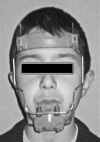Modified tandem traction bow appliance compared with facemask therapy in treating Class III malocclusions
- PMID: 24274958
- PMCID: PMC8650441
- DOI: 10.2319/080513-584.1
Modified tandem traction bow appliance compared with facemask therapy in treating Class III malocclusions
Abstract
Objective: To compare the effects of the modified tandem traction bow appliance (MTTBA) and the facemask in treating patients with Class III malocclusion.
Materials and methods: The material consisted of the pre-post treatment\pre-post observation lateral cephalograms of 65 subjects with skeletal and dental Class III malocclusion. In the first group 21 patients (mean age: 10 years, 6 months) were treated with a Delaire-type facemask (FM). In the second group 22 patients treated (mean age: 10 years) with MTTBA. The remaining 22 children (mean age: 9 years, 7 months) were observed without treatment for 11 months.
Results: Increase in SNA, N-FH ⊥ A, and ANB angles were significantly greater in the treatment groups compared to the control group. However, ANB angle showed a significantly greater increase in the FM group (2.8 ± 0.30°) than in the MTTBA group (2.0 ± 0.18°). The overjet and molar relation increased significantly in both treatment groups, but in the FM group (5.2 ± 0.40 mm) increase in overjet was significantly greater than in the MTTBA group (4.0 ± 0.27 mm). Mesial movement of upper molar and incisor were found to be greater in the FM group compared to the modified TTBA group.
Conclusions: Both appliances were found to be effective in the treatment of Class III malocclusion. Their skeletal and dental effects showed differences due to their design.
Keywords: Class III malocclusion; Facemask; Tandem traction bow.
Figures




References
-
- Bacetti T, Franchi L, McNamara JA., Jr Treatment and posttreatment changes after rapid maxillary expansion and facemask therapy. Am J Orthod Dentofacial Orthop. 2000;118:404–413. - PubMed
-
- De Toffol L, Pavoni C, Bacetti T, Franchi L, Cozza P. Orthopedic treatment outcomes in Class III malocclusion: a systematic review. Angle Orthod. 2008;78:561–573. - PubMed
-
- Ngan P, Hägg U, Yiu C, Merwin D, Wei SHY. Soft tissue and dentoskeletal profile changes associated with maxillary expansion and protraction headgear treatment. Am J Orthod Dentofacial Orthop. 1996;109:38–49. - PubMed
-
- Vaughn GA, Mason B, Moon HB, Turley PK. The effects of maxillary protraction therapy with or without rapid palatal expansion: a prospective, randomized trial. Am J Orthod Dentofacial Orthop. 2005;128:299–309. - PubMed
-
- Chun Y, Jeong SG, Row J, Yang SJ. A new appliance for orthopedic correction of Class III malocclusion. J Clin Orthod. 1999;33:705–711. - PubMed
Publication types
MeSH terms
LinkOut - more resources
Full Text Sources
Other Literature Sources
Research Materials
Miscellaneous

